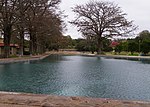Basilica of the National Shrine of the Little Flower
1931 establishments in Texas20th-century Roman Catholic church buildings in the United StatesBasilica churches in TexasRoman Catholic churches completed in 1931Roman Catholic churches in San Antonio ... and 2 more
Roman Catholic churches in TexasTowers in Texas

The Basilica of the National Shrine of the Little Flower also called Our Lady of Mount Carmel and St. Thérèse Church is a historic Roman Catholic church, located in San Antonio, Texas, in the United States. The church is distinguished as one of 84 in the United States (and one of only four in the state of Texas) bearing the papal designation of "minor basilica." Despite its religious importance it is not the cathedral of the local diocese; that distinction belongs to San Fernando Cathedral.
Excerpt from the Wikipedia article Basilica of the National Shrine of the Little Flower (License: CC BY-SA 3.0, Authors, Images).Basilica of the National Shrine of the Little Flower
North Zarzamora Street, San Antonio
Geographical coordinates (GPS) Address Nearby Places Show on map
Geographical coordinates (GPS)
| Latitude | Longitude |
|---|---|
| N 29.445833333333 ° | E -98.525 ° |
Address
Gloria's Imperium
North Zarzamora Street
78201 San Antonio
Texas, United States
Open on Google Maps







